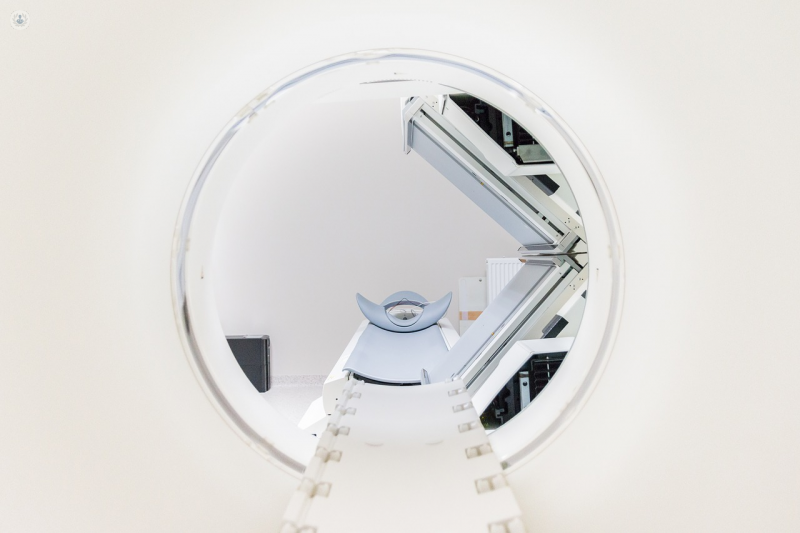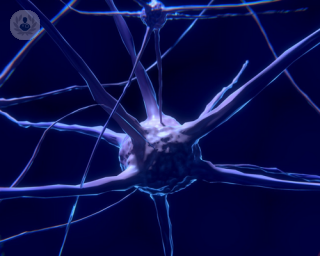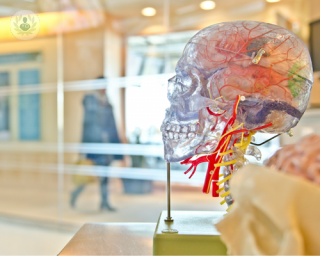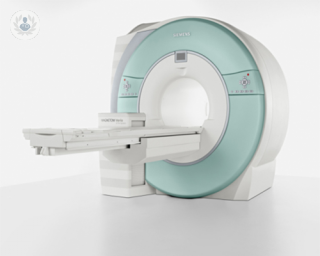What is an MRI?
MRI (magnetic resonance imaging) is a type of scan that doctors use to see the bones, tissues, and organs inside your body. MRI uses strong magnetic fields and radio waves to create highly detailed images, much more detailed than a CT scan or X-ray. This can be very useful when making a diagnosis, or planning surgery.
Some of the most common types of MRI scan include:
- Brain MRI – often used to assess damage to the brain following injury or a stroke, detect tumours, or diagnose degenerative diseases such as Alzheimer’s disease.
- Spinal MRI – used to diagnose degenerative problems in the spine or identify slipped disk, fractures, inflammation, or tumours.
- Abdominal MRI – most often used to diagnose kidney problems but also useful for detecting issues with the liver or gall bladder.
- Breast MRI – usually used in women who have been diagnosed with breast cancer to determine the size and position of the tumour, or tumours.

What does an MRI involve?
An MRI scanner is a large tube surrounded by magnets. The scanner can be used to produce images of any part of your body. An MRI scan involves lying down on a flat bed inside the scanner for a period of time, usually between 15 and 90 minutes, while a radiologist takes several pictures of your body. Each picture can take a few minutes, so it’s important to be as still as possible during the scan.
Preparing for an MRI
Even though an MRI is one of the safest procedures available, not everyone can have an MRI. Because the MRI scanner generates a strong magnetic field, it can be risky if you have something metallic in your body. See this guide from the NHS for a full list of metal implants to consider.
It’s equally important to remove anything metal that you’re wearing, so any jewellery, piercings, hairpins or clothes with metal fasteners should be left at home. You might be asked to wear a hospital gown for the scan.
You should tell the radiologist if you might be pregnant, since the effects of an MRI on a unborn child aren’t yet known.
If you suffer from claustrophobia you can ask for a prescription of a mild sedative to take before the scan. You’ll be transferred to a recovery room after the scan to come round.
Finally, you might receive an injection of a contrast dye to highlight certain parts of the body on the scan. This will be administered using an IV line, inserted into a vein in your hand or arm. The dye is usually safe, but might not be recommended if you have a kidney problem, or recently had surgery, so it’s important to let the doctor know if this applies to you.
What to expect during the MRI scan
Once you’ve removed any metal accessories, and you’ve received the contrast day, you’ll be positioned on the bed and moved into the scanner. You might go in feet first or head first depending on what is being scanned.
The radiologist will operate the scanner from another room, where the magnetic field cannot interfere with their computer, but you’ll be able to speak to them via a microphone placed inside the scanner. At certain points, you might be asked to hold your breath, but it will never be for more than a few seconds.
Sometimes the scanner will make a loud clicking sound as it sends out radio waves. You’ll be given headphones to wear for the noise, and you can listen to music throughout the scan.
The whole process should take between 15 and 90 minutes, depending on the size of the area being scanned and whether or not you need a contrast dye. You can leave straight after the scan, or as soon as you’ve recovered from the sedative.
What happens after the MRI scan?
What happens next will depend on your condition and the type of MRI being performed. It is unlikely you will receive your test result immediately because scan will need to be studied by the radiologist and other specialists.
06-20-2013 02-23-2024MRI
What is an MRI?
MRI (magnetic resonance imaging) is a type of scan that doctors use to see the bones, tissues, and organs inside your body. MRI uses strong magnetic fields and radio waves to create highly detailed images, much more detailed than a CT scan or X-ray. This can be very useful when making a diagnosis, or planning surgery.
Some of the most common types of MRI scan include:
- Brain MRI – often used to assess damage to the brain following injury or a stroke, detect tumours, or diagnose degenerative diseases such as Alzheimer’s disease.
- Spinal MRI – used to diagnose degenerative problems in the spine or identify slipped disk, fractures, inflammation, or tumours.
- Abdominal MRI – most often used to diagnose kidney problems but also useful for detecting issues with the liver or gall bladder.
- Breast MRI – usually used in women who have been diagnosed with breast cancer to determine the size and position of the tumour, or tumours.

What does an MRI involve?
An MRI scanner is a large tube surrounded by magnets. The scanner can be used to produce images of any part of your body. An MRI scan involves lying down on a flat bed inside the scanner for a period of time, usually between 15 and 90 minutes, while a radiologist takes several pictures of your body. Each picture can take a few minutes, so it’s important to be as still as possible during the scan.
Preparing for an MRI
Even though an MRI is one of the safest procedures available, not everyone can have an MRI. Because the MRI scanner generates a strong magnetic field, it can be risky if you have something metallic in your body. See this guide from the NHS for a full list of metal implants to consider.
It’s equally important to remove anything metal that you’re wearing, so any jewellery, piercings, hairpins or clothes with metal fasteners should be left at home. You might be asked to wear a hospital gown for the scan.
You should tell the radiologist if you might be pregnant, since the effects of an MRI on a unborn child aren’t yet known.
If you suffer from claustrophobia you can ask for a prescription of a mild sedative to take before the scan. You’ll be transferred to a recovery room after the scan to come round.
Finally, you might receive an injection of a contrast dye to highlight certain parts of the body on the scan. This will be administered using an IV line, inserted into a vein in your hand or arm. The dye is usually safe, but might not be recommended if you have a kidney problem, or recently had surgery, so it’s important to let the doctor know if this applies to you.
What to expect during the MRI scan
Once you’ve removed any metal accessories, and you’ve received the contrast day, you’ll be positioned on the bed and moved into the scanner. You might go in feet first or head first depending on what is being scanned.
The radiologist will operate the scanner from another room, where the magnetic field cannot interfere with their computer, but you’ll be able to speak to them via a microphone placed inside the scanner. At certain points, you might be asked to hold your breath, but it will never be for more than a few seconds.
Sometimes the scanner will make a loud clicking sound as it sends out radio waves. You’ll be given headphones to wear for the noise, and you can listen to music throughout the scan.
The whole process should take between 15 and 90 minutes, depending on the size of the area being scanned and whether or not you need a contrast dye. You can leave straight after the scan, or as soon as you’ve recovered from the sedative.
What happens after the MRI scan?
What happens next will depend on your condition and the type of MRI being performed. It is unlikely you will receive your test result immediately because scan will need to be studied by the radiologist and other specialists.


The importance of seeing a neurologist after a stroke
By Dr Arvind Chandratheva
2024-12-26
When a stroke happens, every moment counts. Immediate medical attention can save lives and enhance recovery prospects. However, the importance of seeing a neurologist after a stroke is also important when it comes to recovery. Their expertise is essential regarding both acute care and long-term management. Here to discuss this important topic is leading consultant neurologist, stroke and rehabilitation physician Dr Arvind Chandratheva. See more


Cerebral small vessel disease and why it's so important
By Professor Hedley Emsley
2024-12-26
Even though cerebral small vessel disease is very common, you may never have heard of it. It affects most older people but should not be thought of as part of the normal ageing process. It can also be seen in younger adults. It’s entirely possible to have it yet not know about it. Very often small vessel disease goes undetected. But if it is identified then it is sensible to think about how to reduce the risk of it causing future problems. Here to provide an in-depth look at this condition is leading consultant neurologist and vascular neurology specialist Professor Hedley Emsley. See more


What are the different kinds of non-invasive cardiac imaging tests?
By Dr Yousef Daryani
2024-12-26
You may have been told by your doctor that you need cardiac imaging to check for heart disease, or you may have symptoms of heart disease and want to be checked by a specialist. With the help of leading consultant cardiologist, Dr Yousef Daryani talks through the different procedures, and what to expect. See more


An introduction to functional neurological disorder (FND)
By Dr Michael Newson
2024-12-25
Leading consultant psychiatrist Dr Michael Newson tells us all about functional neurological disorder (FND) in this informative article. See more
Experts in MRI
-
Dr Graham Cole
CardiologyExpert in:
- Echocardiogram
- Heart failure
- MRI
- Shortness of breath
- Valvular heart disease
- Angina
-
Dr Ravi Assomull
CardiologyExpert in:
- Heart check up
- MRI
- Preventive cardiology
- Sports cardiology
- Coronary CT
-
Professor Waqar Bhatti
RadiologyExpert in:
- Sports Reviews
- MRI
- DEXA scan
- Spine MRI
- Musculoskeletal ultrasound
- Sports injuries
-
Dr Gulraiz Ahmad
RadiologyExpert in:
- Imaging diagnostic system
- Sports injuries
- Ultrasound
- Musculoskeletal ultrasound
- CT scan (CAT)
- MRI
-
Dr Kathrin Hammer
RadiologyExpert in:
- MRI
- Ultrasound
- Spine MRI
- Sports injuries
- CT scan (CAT)
- Musculoskeletal ultrasound
- See all

The Highfield Hospital - part of Circle Health Group
The Highfield Hospital - part of Circle Health Group
Manchester Road, Rochdale, Lancashire, OL11 4LZ
No existe teléfono en el centro.
By using the telephone number provided by TOP DOCTORS, you automatically agree to let us use your phone number for statistical and commercial purposes. For further information, read our Privacy Policy
Top Doctors

London Bridge Hospital - part of HCA Healthcare
London Bridge Hospital - part of HCA Healthcare
27 Tooley St
No existe teléfono en el centro.
By using the telephone number provided by TOP DOCTORS, you automatically agree to let us use your phone number for statistical and commercial purposes. For further information, read our Privacy Policy
Top Doctors

Alliance Medical Marylebone
Alliance Medical Marylebone
10-11 Bulstrode Place, London. W1U 2HX
No existe teléfono en el centro.
By using the telephone number provided by TOP DOCTORS, you automatically agree to let us use your phone number for statistical and commercial purposes. For further information, read our Privacy Policy
Top Doctors
-
The Highfield Hospital - part of Circle Health Group
Manchester Road, Rochdale, Lancashire, OL11 4LZ , RochdaleExpert in:
- Cardiology
- Orthopaedic surgery
- Plastic surgery, reconstructive and aesthetics
- Dermatology
- Diagnostic Imaging
- Endocrinology
-
London Bridge Hospital - part of HCA Healthcare
27 Tooley St, Central LondonExpert in:
- 24-hour service
- Cardiology
- Minimal access surgery (keyhole surgery)
- Orthopaedic surgery
- Cardiovascular disease
- Gastroenterology
-
Alliance Medical Marylebone
10-11 Bulstrode Place, London. W1U 2HX, Central LondonExpert in:
- Cardiology
- Diagnostic Imaging
- Ultrasound
- Gastroenterology
- Neurology
- Magnetic resonance
- See all
- Most viewed diseases, medical tests, and treatments
- Immunotherapy
- Alzheimer's disease
- Visual impairment
- Diabetic retinopathy
- Retina
- Visual stress (Meares-Irlen syndrome)
- Presbyopia
- Nystagmus
- Myopia
- Hyperopia (farsightedness)







